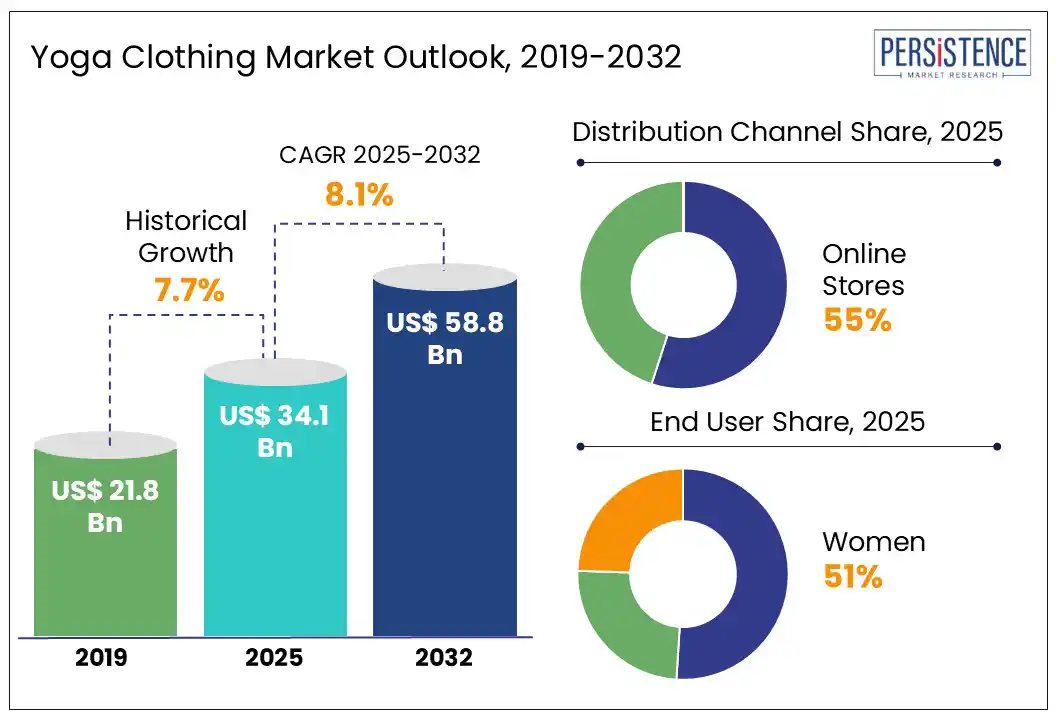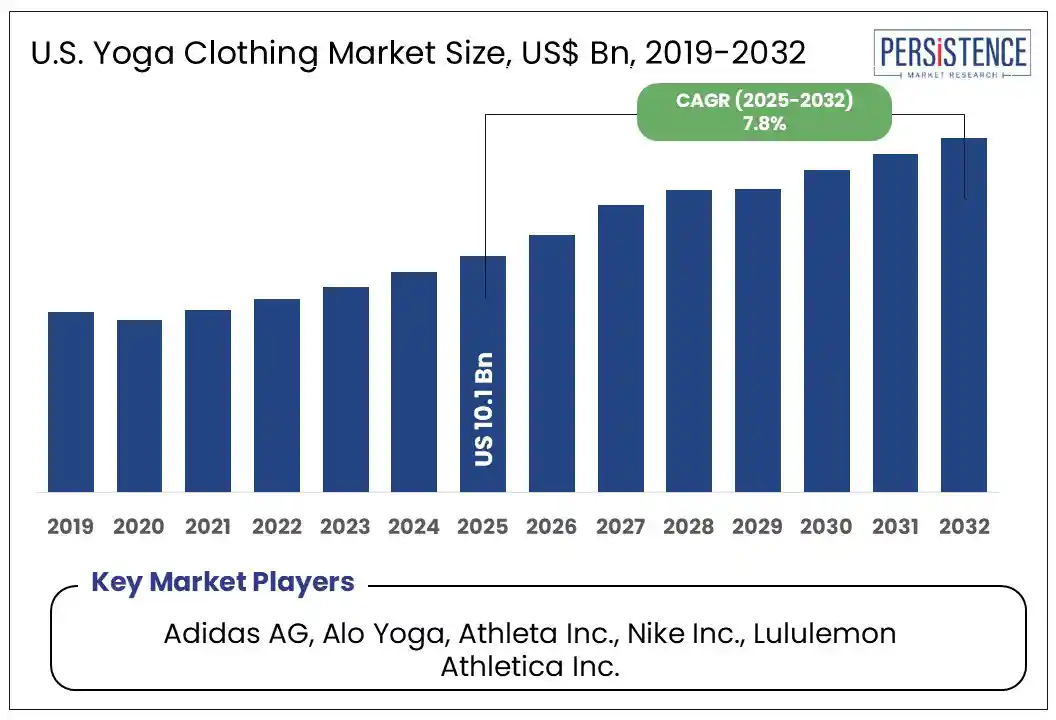ID: PMRREP35182| 191 Pages | 7 Jul 2025 | Format: PDF, Excel, PPT* | Consumer Goods

The global yoga clothing market size is likely to be valued at US$ 37.7 Bn in 2025 and is expected to reach US$ 58.8 Bn by 2032, growing at a CAGR of 8.1% in the forecast period from 2025 to 2032.
According to the Persistence Market Research report, the yoga apparel market is undergoing rapid growth due to the global rise in health and fitness, with yoga gaining momentum as a legitimate form of wellness practice and a lifestyle. With the increase in people relying on yoga for their physical and mental wellbeing, there will be a continued demand for functional, fashionable and eco-friendly yoga apparel.

Key Industry Highlights:
|
Global Market Attribute |
Key Insights |
|
Yoga Clothing Market Size (2025E) |
US$ 37.7 Bn |
|
Market Value Forecast (2032F) |
US$ 58.8 Bn |
|
Projected Growth (CAGR 2025 to 2032) |
8.1% |
|
Historical Market Growth (CAGR 2019 to 2024) |
7.7% |
The growing awareness of all health benefits associated with yoga is leading to an increase in participation around the world, and as a result, a bubble in demand for premium yoga clothing. Yoga not only improves strength, balance, and flexibility, which helps to prevent injuries or decrease problems with arthritis and back pain, but it is cardio-protective by reducing stress, which is confirmed to be linked with high blood pressure and cardiovascular diseases, and by reducing inflammation.
On the psychological level, yoga improves mood, increases energy, and reduces sleep disturbance. One study of 64 women with PTSD showed that after doing yoga once a week for 10 weeks, 54% no longer had PTSD symptoms. As the benefits of yoga become more widely valued and appreciated, more people are adopting yoga as part of their regular lives, which is leading to an increased and growing demand for comfortable yet stylish clothing in the yoga apparel market. Consumers are looking for clothing that enhances the quality of movement and does not break their transition from the gym to work or life.
Premium yoga apparel brands have a difficult time gaining traction in price-conscious markets that primarily consider price when making purchasing decisions. Although premium brands such as Lululemon, Alo Yoga, and Beyond Yoga offer great quality in everything from fabrics and sustainable sources to innovative designs, the premium prices create obstacles.
In markets like India and Southeast Asia, and parts of Latin America, affordability remains a crucial factor influencing purchasing decisions. Consumers in these regions frequently choose local, lower-cost alternatives that offer functional activewear for a fraction of the cost. For example, fast-fashion retailers like Zara have created stiff competition to premium yoga wear brands with stylish yoga outfits at affordable prices. As such, premium yoga wear offers great consumer appeal, however, it will continue to be constrained by financial realities in both emerging and developed markets.
The growing demand for sustainable fashion is a big opportunity for the yoga clothing market. As environmental consciousness of consumers has increased, they have begun to choose eco-friendly materials such as organic cotton, bamboo, hemp, and recycled fabrics. In response, major brands are stepping up to introduce environmentally friendly collections that are in line with carbon emissions reduction as well as textile waste reduction.
Adidas has taken a step to combine sustainable high-performance design and sustainability, along with the use of innovative materials such as recycled ocean plastics and regenerated fibers that meet the growing demand for eco-conscious activewear.
This change is significantly driven by Gen Z and millennial shoppers who highly value sustainability in their purchasing decisions. Consequently, those brands that concentrate on green practices find themselves not only different from others in the crowded market but also build a strong customer loyalty from eco-conscious consumers. In the long run, sustainable yoga clothing is becoming both a responsible and profitable path forward.
In the yoga clothing market, women participation represents most of the shares, accounting for a leading demand for the clothes that have a combination of performance, comfort, and style. Approximately 72% of yoga practitioners in the U.S. are female, while only 28% are male in the U.S. As yoga becomes the fundamental element of many fitness routines, women are deciding to have outfits that not only feel good but are also easy to move in and are visually appealing.
The most popular pieces, such as high-waisted leggings, supportive sports bras, and seamless tops, are favored by consumers because they can flatter the body and even make it feel easier to move. In support of this claim, Nike's Yoga Dri-FIT Luxe High-Waisted 7/8 Leggings fit the body perfectly while allowing mobility and coverage, which is suitable not only for slow flows but also for the more vigorous ones, as they were made for that purpose.
Functions like moisture-wicking fabrics, breathable panels, and four-way stretch have become essentials. With social media trends and celebrity endorsements shaping tastes, brands are prioritizing both performance and fashion to win over this powerful consumer group.
E-commerce has become the go-to way for people to shop for yoga clothing, thanks to its convenience, competitive prices, and wide selection. More consumers now prefer buying online over visiting physical stores, largely because of easy browsing, flexible return options, and access to exclusive deals.
Major platforms such as Amazon, as well as official websites of brands such as Nike, Lululemon, and Alo Yoga, offer a smooth, user-friendly shopping experience. Customers can explore detailed product descriptions, read real reviews, and get personalized recommendations all from the comfort of home. Lululemon’s strong digital performance in 2024 reflects this trend, with online sales making up 41% of its total revenue and helping drive a 10.4% increase in quarterly net sales.
With the rise of social commerce and influencer marketing, brands can now connect with their audience directly, launch exclusive online collections, and reach customers around the world making e-commerce the heart of the modern yoga apparel industry.
The increasing emphasis on holistic wellness, mental health, and physical fitness has significantly contributed to the surge in yoga’s popularity across North America. Notably, current estimates indicate that approximately 36 million Americans engage in regular yoga practice, with a marked uptick among millennials and members of Generation Z. This heightened participation has directly influenced consumer demand for yoga apparel that balances comfort, flexibility, and style.
Leading industry players such as Lululemon, Alo Yoga, and Athleta have responded by innovating with fabrics that are not only moisture-wicking and stretchable but also environmentally sustainable. These brands have expanded their product lines to offer apparel that transitions seamlessly from exercise to everyday wear, reflecting the growing adoption of athleisure in contemporary fashion. The proliferation of online yoga classes and fitness applications has further reinforced the need for functional and versatile yoga clothing.
As yoga continues to evolve from a fitness activity into a broader lifestyle choice, the North American yoga apparel market is demonstrating robust growth.
The proliferation of yoga retreats, studios, and practitioners across Europe has notably increased the demand for specialized yoga clothing. As individuals increasingly turn to yoga for purposes such as wellness, stress reduction, and physical fitness, the market for comfortable, functional, and aesthetically appealing activewear has expanded correspondingly. In countries such as Germany, France, and the United Kingdom, there has been a marked rise in yoga studio memberships, the integration of yoga into corporate wellness initiatives, and the popularity of destination retreats in natural ,settings.
Retreats such as Shama Retreats led by Paloma Dorado, are situated in tranquil natural environments, offering participants opportunities to disengage from urban stressors and focus on holistic well-being through structured yoga and wellness activities. Similarly, Wild Swimming Retreats in the UK combine outdoor swimming with yoga, thereby fostering a sense of community and a deeper connection to nature.
As yoga continues to integrate aspects of wellness, fitness, and lifestyle, the European market for yoga apparel is positioned for continued growth, propelled by the expanding and increasingly engaged yoga community.
India stands as the acknowledged birthplace of yoga, a practice that has evolved from its ancient spiritual roots into a significant component of both global and domestic well-being culture. In recent years, yoga’s adoption has expanded considerably, not merely as a means of physical fitness, but as an expression of India’s cultural and spiritual heritage.
Notably, the Indian government has played a pivotal role in this resurgence. The nation’s successful proposal to the United Nations led to the establishment of the International Day of Yoga, observed worldwide on June 21st each year. Domestically, the Ministry of AYUSH has been established to oversee the promotion, research, and integration of yoga within public health frameworks. Moreover, yoga has been formally incorporated into the NCERT curriculum for school students, ensuring early exposure through Health and Physical Education modules.
Parallel to these efforts, there has been marked growth in yoga-related tourism, wellness retreats, and corporate wellness programs. These trends have generated increased demand for comfortable, breathable, and culturally resonant yoga apparel. In response, brands are innovating with materials such as organic cotton, bamboo textiles, and handwoven fabrics to cater to environmentally conscious consumers.

The global yoga clothing market is highly competitive, with numerous brands offering innovative, high-performance apparel. Companies are focusing on sustainability, advanced fabric technology, and stylish designs to attract consumers. The market sees strong competition between premium, mid-range, and budget-friendly brands, each catering to different demographics.
The rise of direct-to-consumer models and e-commerce platforms has further increased competition, allowing emerging brands to gain traction without relying on traditional retail channels. The rising demand for eco-friendly yoga wear has led to increased investment in organic fabrics, recycled materials, and ethical production. With growing global awareness of yoga, the market is expected to remain dynamic and innovation-driven.
The Yoga Clothing market is estimated to be valued at US$ 34.1 Bn in 2025.
Rising awareness about health benefits of yoga is the key demand driver for Yoga Clothing market.
In 2025, North America region dominates the market with a 20.1% share in the global Yoga Clothing market.
Among end-user segment, demand from the women’s yoga clothing segment is expected to grow rapidly at 8.3% CAGR from 2025-2032.
Adidas AG, Alo Yoga, Athleta Inc., Nike Inc., and Lululemon Athletica Inc. are the leading players in the Yoga Clothing market.
|
Report Attribute |
Details |
|
Historical Data/Actuals |
2019 - 2024 |
|
Forecast Period |
2025 - 2032 |
|
Units |
Value: US$ Bn/Bn, Volume: As applicable |
|
Geographical Coverage |
|
|
Segmental Coverage |
|
|
Competitive Analysis |
|
|
Report Highlights |
|
|
Customization and Pricing |
Available upon request |
By Clothing Type
By End-user
By Distribution Channel
By Region
Delivery Timelines
For more information on this report and its delivery timelines please get in touch with our sales team.
About Author